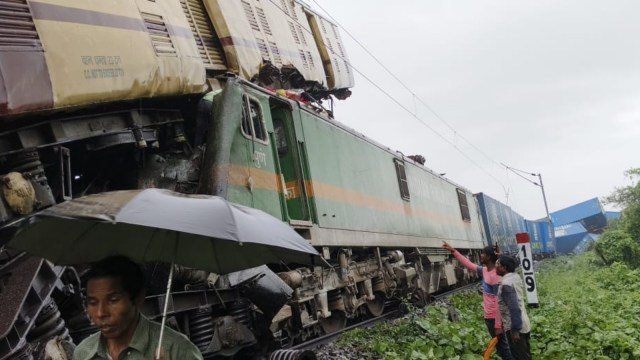Human error, disregard for signal, automatic signalling system down – what happened before goods train rammed Kanchanjunga Express
A railways source present at the site of the accident told The Indian Express that at least four trains had passed the signal before the goods train.
 The goods train had rammed the Kanchanjunga Express from the rear, derailing three of its coaches. (Photo: Sourced by Express)
The goods train had rammed the Kanchanjunga Express from the rear, derailing three of its coaches. (Photo: Sourced by Express)The rail accident in New Jalpaiguri that claimed nine lives could be because of negligence on part of the goods train’s loco pilot, a prima facie assessment of the incident has found. Documents accessed by The Indian Express also show that the automatic signalling system on the line was down and the trains were given ‘paper line clearance’ by the Rangapani station manager to cross.
The goods train had rammed the Kanchanjunga Express from the rear, derailing three of its coaches.
“Prima facie, it appears to be human error but we will know more after the inquiry,” Railway Board chairperson Jaya Varma Sinha told reporters. “Unfortunately, the driver (of the goods train) also perished in the accident… So we have no authentic way of knowing what exactly happened. Whatever we can gather from the situation, it seems there was a disregard for the signal.”
A railways source present at the site of the accident told The Indian Express that at least four trains had passed the signal before the goods train. “The protocol for the automatic signalling system is that if there is a red light, the loco pilot has to stop the train for a minute and then proceed ahead at a moderated speed while engaging the horn. In this case, it looks like the pilot did not slow down at the signal,” the official said.
The source also claimed that the loco pilot had rested at his headquarters in Uttar Pradesh. He signed in at 6:30 am, and the accident took place at 8.55 am.
To be sure, a comprehensive enquiry of the incident is yet to take place, and these are prima facie findings by Railway officials.
Kavach – the made-in-India automatic train protection system to help prevent accidents if two trains are travelling on the same line – was not available on this particular line, officials said.
A union of the loco pilots objected to claims being made by Railways officials. “It is highly objectionable to announce the loco pilot responsible when he is dead and CRS inquiry is pending,” Sanjay Pandhi, the working president of the Indian Railway Loco Running Men Organisation, said.
According to records accessed by The Indian Express, since the automatic signalling system was down, the Kanchenjunga Express was given a ‘paper line clearance’ to cross at 8.20 am, and the goods train at 8.35 am.
“Automatic signalling has failed and you are hereby authorised to pass all automatic signals between RNI (Rangapani) station and CA-T (Chattar Hat) station,” it stated.
“In addition, you are also authorised to pass semi-automatic/manually operated/gate stop signals on being signalled past such signals by a railway servant in uniform,” it read.
While Railways said that prima facie, there had been a “disregard for the signal” by the loco pilot, officials of the Northeast Frontier Railway said even this does not fully explain the collision. “It is very difficult for a train to hit another from the rear when it can be sighted. Even if a train disregards one signal, railway men are supposed to raise an alarm. Both trains were supposed to slow down. It seems one did and another did not,” said a senior official.
Samir Goswami, former CPRO, Eastern Railways, said, “In this route, the automatic signalling system was under maintenance. In this situation, the train has power to cross the red signal but the rule is, in daytime, they have to stop at the signal for one minute and then they can scroll but at 10 kmph. We know that Kanchanjunga Express followed that rule but the goods train did not. Question is, why? This can be known from the pilot and co-pilot of the goods train but the unfortunate part is both of them are dead. The guard of the Kanchanjungha Express also died in the incident. So no eyewitnesses remain.”
Another rail official said the administration will, among other things, check visibility during the time.
A retired train guard said the pilot and co-pilot “cannot sleep at the same time”. “Even if the automatic signal is down, the manual signal is supposed to be there even after paper line clearance. Goods trains run at high speed but in such a situation, they have to slow down. Moreover, if a goods train overshoots a signal, the upcoming signal is alerted,” he said.







